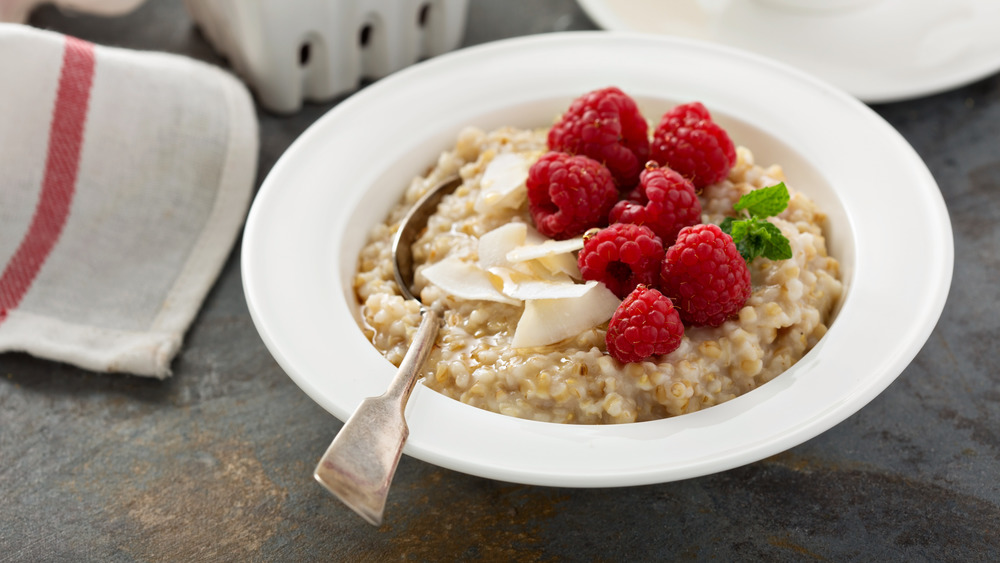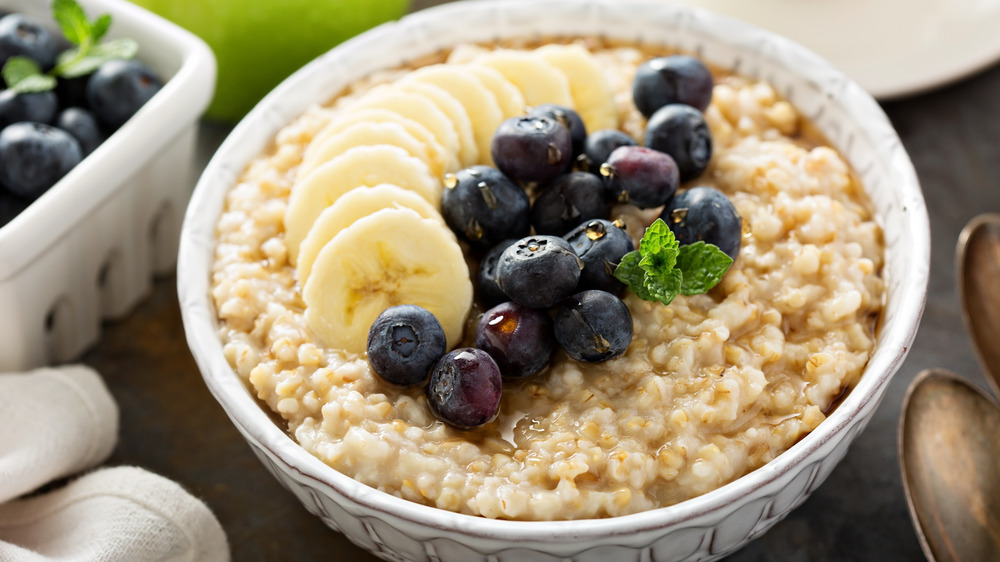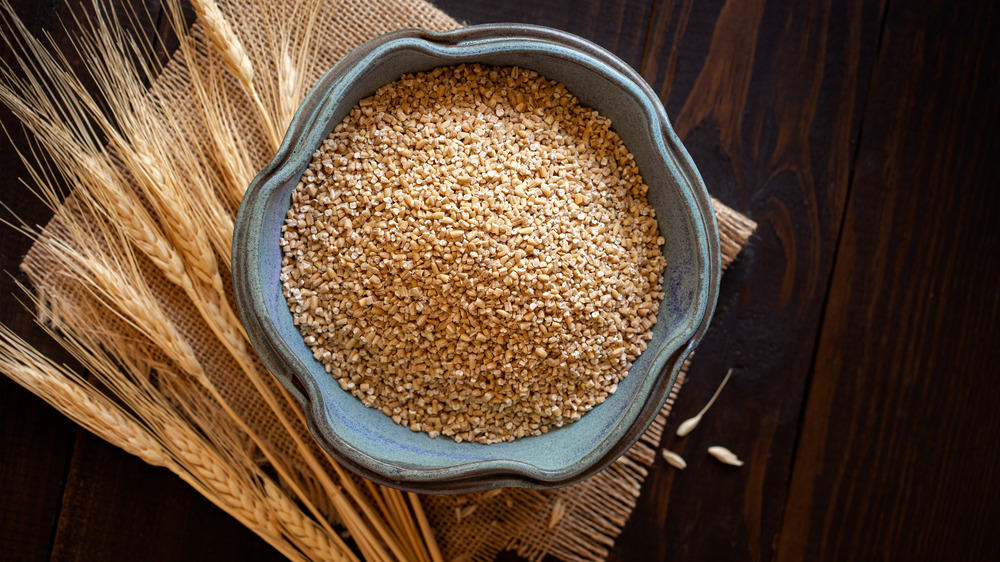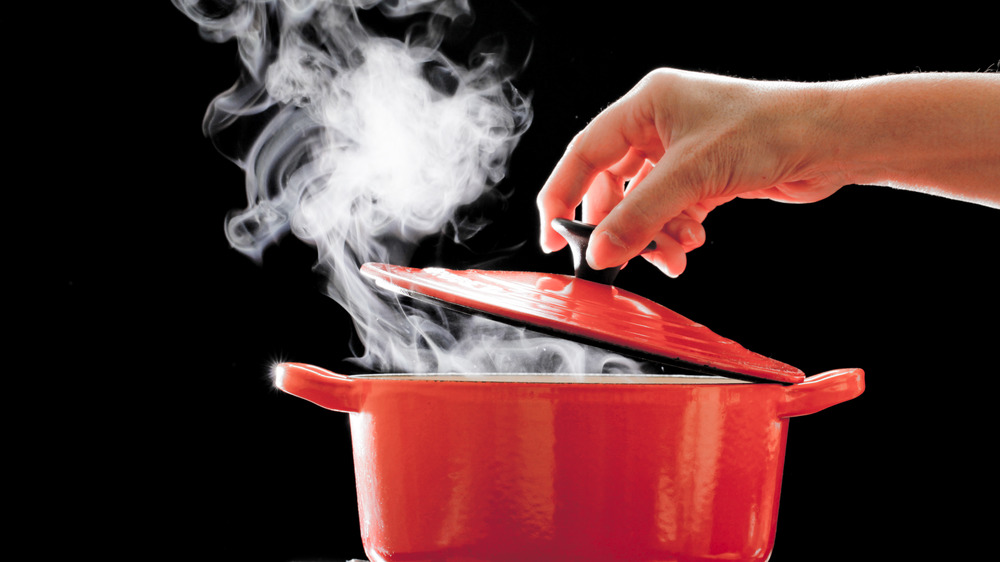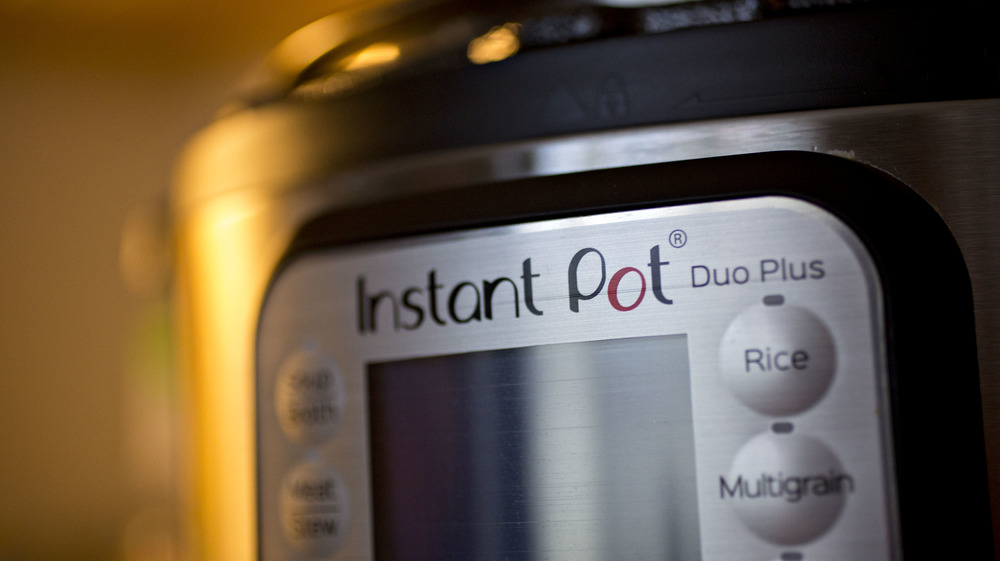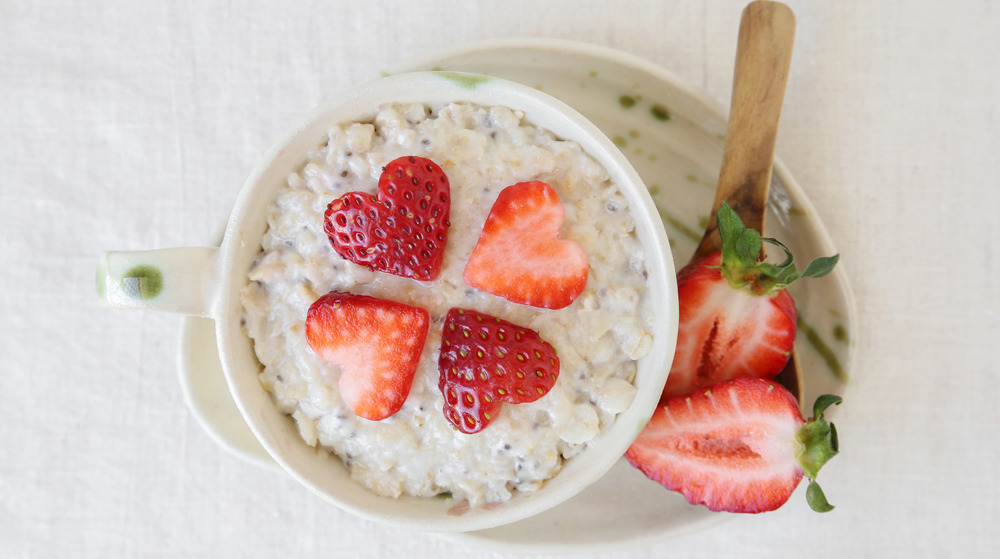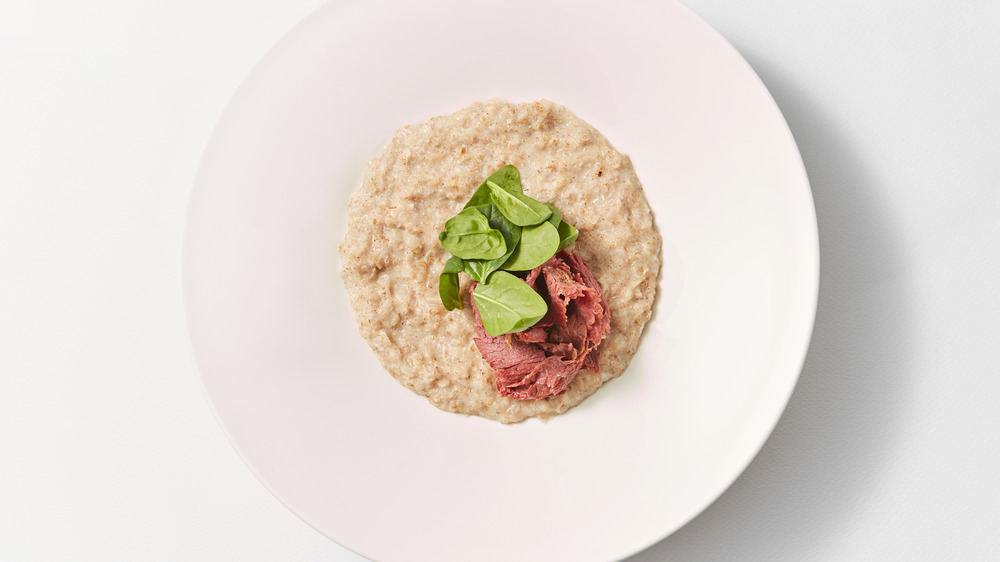The Untold Truth Of Steel Cut Oats
Pity the poor, misunderstood steel cut oat, quite possibly one of the world's hardest-working yet least-appreciated grains. When humans began farming around 12,000 years ago (via NPR), oats were regarded as weeds and even a "diseased version of wheat," according to Bellevue University's Facts from the Stacks blog. Even when the Scots first began cultivating oats, it was only because they had made the disappointing discovery that Scotland was ill-suited for wheat cultivation. In fact, for many centuries across Europe, oats were considered a "coarse" and lowly food, according to The Washington Post.
Over in the United States, steel cut oats were nothing more than animal feed until the second half of the nineteenth century. That's when Quaker Oats founder, Ferdinand Schumacher invented "rolled oats," which cooked up faster and managed to look considerably less like animal feed. Although oatmeal's reputation suffered during the rise of low-carb dieting, the tide has been turning thanks to renewed interest in plant-based eating. This is especially true with regard to steel cut oats, which nutrition experts such as Aubrey Bailey are now referring to as a "power food" (via LiveStrong).
But are steel cut oats really a power food? Or is saying so nothing more than a way of justifying eating a big bowl of carbs for breakfast? For that matter, what even are steel cut oats? Read on for the untold truth of the steel cut oats, that longtime underdog of the grain family, which was once regarded as unfit for humans.
What exactly are steel cut oats?
Steel-cut oats, sometimes referred to as "Irish oats" according to Simply Oatmeal, are one of the two main kinds of oatmeal. The other is "rolled oats," which, thanks to Quaker Oats, is far more familiar to most Americans. But enough about rolled oats, which have been upstaging steel cut oats in America for close to 150 years now. We're here to talk about steel cut oats, the original oatmeal, the oatmeal that has its roots in an oat preparation technique that's been around for 32,000 years (via New Scientist). And here's what's ironic about that. It's "rolled oats" that are known as "old-fashioned oats," even though they weren't even invented until the late 19th century as a marketing ploy by the founder of Quaker Oats.
Steel-cut oats, which are comprised of hulled oat grains cut into small nuggets with a steel blade, can probably be best be described as the oat-version of risotto. When cooked in liquid, their individual pieces dissolve only partially, retaining some semblance of their shape while melding into one another to form a creamy yet chewy porridge. By contrast, rolled oats, which are steamed and then rolled flat during processing, dissolve into mush when cooked in liquid. Steel-cut oats offer a subtle nutty flavor, owing to their shape, which exposes multiple surface areas to the toasting that's part of their processing. Although rolled oats are toasted too, their flavor is more bland, owing to their uniformly smooth and flattened surface.
Steel cut oats are as unprocessed as it gets when it comes to oatmeal
Steel-cut oats are subjected to less processing than rolled oats, according to Harvard's Nutrition Source. For any kind of oatmeal, processing begins with cleaning, purifying, and hulling the oat grain. What's left of the grain after hulling, which Simply Oatmeal reports is called a "groat", is then toasted. The toasting is intended to cultivate a nutty flavor and also to help discourage the growth of harmful bacteria, according to registered dietitian Sarah Schlicter (via My Fitness Pal).
After that, in order to produce rolled oats, the toasted oat groat is steamed and then flattened between roller wheels. By contrast, to produce steel cut oats, there is no steaming or pre-cooking of any kind and certainly no flattening going on. Instead, the toasted oat groat is simply chopped up into several pieces using a steel blade. In the case of "quick-cooking" steel cut oats, the grain is cut into still more pieces (via University of Massachusetts Center for Applied Nutrition). And in the case of "Scottish oats," the pieces are ground still smaller into a cornmeal-like consistency, which is how oat-meal got its name (via Bob's Red Mill).
Steel cut oats take longer to cook than other kinds of oats
By virtue of their irregular shape and the fact that they are denser than rolled oats, steel cut oats have to absorb more liquid during the cooking process than rolled oats, according to registered dietitian Melissa Wdowik (via Colorado State University). For this reason, it can take up to 30 minutes to cook steel cut oats on the stovetop, whereas it only takes between two and five minutes for rolled oats (via Healthline).
If half an hour seems like too much time to spend on prepping breakfast in the morning, there is a way to have a fresh batch actually waiting for you in the morning. According to Bob's Red Mill, to make "overnight oats," you just have to mix your oats with the liquid of your choice (like water, almond milk, or milk) at a 1:3 ratio, and then leave it in the refrigerator overnight while you sleep. In the morning, your steel cut oats will be ready for you to eat — straight from the fridge. While you should feel free to warm them up on the stove or in the microwave, you don't have to if you're in a rush or simply want a cold breakfast.
You can cook steel cut oats in an Instant Pot
Let's say you forgot to soak your steel cut oats overnight or maybe you just don't relish the idea of steeping your steel cut oats in refrigerated liquid all night. There's still another way to enjoy a fresh, steaming hot bowl of steel cut oatmeal first thing in the morning. You just have to be one of the many proud owners of an Instant Pot.
If that's the case in your kitchen, Bob's Red Mill recommends simply placing your oats and your liquid at a 1:3 ratio in your Instant Pot. Depending on the size of your Instant Pot, you may find it makes sense to prepare multiple servings of steel cut oats at a time. In fact, your Instant Pot's user manual may specify that you'll need to use a minimum of at least one cup of water for the pot to come to work properly. So definitely check your manual before proceeding.
However much you're making, simply give it a quick stir, set your Instant Pot to "high" pressure, and set the timer for three minutes. When the cooking time is up, release the pressure, take the lid off the pot, stir, and enjoy.
Steel-cut oats may help control your blood sugar
From a nutritional standpoint, steel cut oats are almost indistinguishable from rolled oats (via Inside the Mill). A single 154-calorie serving of either delivers 6 grams of protein, 3 grams of fat, 28 grams of carbs, and 4 grams of fiber. That serving of oatmeal is also a rich source of micronutrients, including thiamin (vitamin B1), iron, magnesium, and selenium (via Healthline). Both forms of oats are also rich in Beta-glucan (β-glucan), a soluble fiber that has been associated with numerous health benefits (via Journal of Nutrition and Metabolism).
However, one very important distinction between steel cut and rolled oats — one which makes steel cut oats a potentially "healthier" choice than rolled oats — is that, due to their shape and consistency, steel cut oats take longer to digest than rolled oats, according to the Harvard School of Public Health. As a result, steel cut oats raise your blood sugar more gradually than rolled oats. In other words, they have a lower glycemic index, which can be a pretty significant fact for people who need to watch their blood sugar, like individuals with diabetes. So, while all oats offer blood sugar regulation benefits, steel cut oats may deliver a slight edge because of their lower glycemic index. They may also help you to feel fuller longer and even have a hand in suppressing appetite, according to Dr. Reza Norouzy (via the Society for Endocrinology).
Eating steel cut oats can actually help you lower your cholesterol levels
Steel-cut oats, and, in fact, all oats, are a rich source of fiber. A 100-gram serving (which amounts to a little more than half a cup of uncooked steel cut oats) delivers 10 grams of the stuff, including two grams of soluble fiber (via USDA). Both insoluble and soluble fiber offers important health benefits, but it is believed that soluble fiber in particular, which creates a gel when dissolved in liquid, may help manage and even lower your cholesterol levels. That's according to the Harvard Health Letter, which explained that the gel "traps some of the cholesterol in your body, so it's eliminated as waste instead of entering your arteries."
Additionally, the soluble fiber in oats happens to include one called "Beta-glucan" or "β-glucan," according to the Harvard School of Public Health. In multiple studies over the past 23 years, consumption of oat-derived β-glucan has been found to be associated with a decrease in total serum cholesterol levels and, specifically, low-density lipoprotein (the "bad" cholesterol), according to the authors of a 2011 study published in the journal Nutrition Reviews. And that's important because high cholesterol levels are associated with a greater risk of heart disease and stroke, according to the Centers for Disease Control and Prevention. Fortunately, getting those numbers down can significantly lower that risk, according to Mason Freeman, MD, an endocrinologist and chief of the Lipid Metabolism Unit at Mass General, (via Massachusetts General Hospital).
Steel cut oats are so good at lowering cholesterol, they're legally entitled to brag about it
There is so much compelling scientific evidence that the soluble fiber in oatmeal can help lower serum cholesterol levels and thereby help to decrease the risk of coronary heart disease that, in 1997, the U.S. Food and Drug Administration granted oatmeal producers the FDA's very first permission to include a "food-related health claim" on their labeling, according to the Harvard Heart Letter.
"Authorized health claims in food labeling are claims that have been reviewed by FDA and are allowed on food products or dietary supplements to indicate that a food or food component may reduce the risk of a disease or a health-related condition," says the FDA. To earn the FDA's labeling permission, all such claims have to be supported by "significant scientific agreement among qualified experts." That's a pretty good pedigree for steel cut oats and oats in general. The specific health claim that oatmeal makers are permitted to include on their labeling is that "Diets high in oatmeal or oat bran and low in saturated fat and cholesterol may reduce the risk of heart disease."
Eating steel cut oats could reduce your blood pressure
In addition to helping to lower cholesterol, eating steel cut oats and other oatmeals may help to lower your blood pressure, according to a 2012 research paper published in the Journal of Nutrition and Metabolism. The research paper consisted of a review of the then-current body of scientific knowledge regarding the role of β-glucans in preventing and treating metabolic syndrome, a cluster of conditions that together are associated with a higher risk of heart disease and stroke, according to Mayo Clinic. One of those conditions is high blood pressure.
Although blood pressure is the least studied among the various conditions comprising metabolic syndrome, the study authors nevertheless managed to identify a study in which people who consumed 8 grams of soluble oat fiber per day over a 12-week period, significantly reduced their blood pressure. They also found a meta-analysis (a data analysis using multiple studies addressing roughly the same topic) demonstrating that among people with diagnosed hypertension, an increase in fiber intake in general (not specifically soluble fiber) helped to reduce blood pressure. What the authors were not able to pinpoint based on the existing research was why soluble fiber seems to protect against hypertension, which will have to be the subject of further study.
Eating steel cut oats could help you lose weight
Since steel cut oats take longer to digest than rolled oats, they have the extra-added advantage of helping you to feel satisfied for longer, according to registered dietitian Melissa Wdowik (via Colorado State University). And feeling satisfied for longer can help you to have better control over your weight, according to Healthline.
Since it delivers 10 grams of fiber per 100-gram serving (via USDA), oatmeal is considered a high-fiber food. According to registered dietitian Tanya Zuckerbrot, the very act of digesting high fiber foods may require your body to expend more energy (that is, calories) than it would in the course of digesting relatively low-fiber foods (via Prevention). A 2020 study published in the JAMA Network demonstrated that a low-fat, high-fiber, plant-based diet can help reduce body weight, in part by increasing post-meal metabolism. Essentially, it could be that meals full of things like steel-cut oats can help you burn extra calories.
Conversely, foods with little to no fiber can actually leave your metabolism operating more slowly, according to Zuckerbrot. So every time you choose steel cut oats instead of, say, a bagel made with white flour, you're helping keep your metabolism running at optimal speed. Please note that you're also slowing down your metabolism if you're doing any of these things.
When you eat steel cut oats, you're doing right by your digestive system
In addition to keeping the metabolism chugging along, oatmeal's high fiber content helps supports a healthy balance of gut bacteria, according to registered dietitian Judy Palken, via the University of Massachusetts Medical School's Center for Applied Nutrition. "When oat fiber reaches the large intestine, it is metabolized by the good bacteria that live there, who then decrease inflammation and promote good gastrointestinal health," she explained. In fact, this "prebiotic" quality is the primary reason the UMass Medical School's Center for Applied Nutrition promotes the consumption of steel cut oats among people with inflammatory bowel disease.
Along with the soluble fiber that scientists have found may be associated with lowering cholesterol and blood pressure (via the Journal of Nutrition and Metabolism), steel cut oats are also rich in insoluble fiber. Unlike soluble fiber, which dissolves into a gel when it comes into contact with water, insoluble fiber does not dissolve at all. In fact, it remains "relatively intact" as it moves through the digestive system, according to the Mayo Clinic. As a result, it helps the other food that you've eaten to move through your digestive system more efficiently, and that helps promote regularity and prevent constipation, according to the Harvard School of Public Health.
Steel cut oats are not just a breakfast food
Steel-cut oats are so beloved by nutrition experts that they made our list of the five foods that you should always feel good about eating for breakfast. But as much as we may talk about steel cut oats in the breakfast context, the fact is that steel cut oats are not just breakfast food. At least, they don't have to be. "We tend to associate oats with breakfast, but they are actually a grain, like rice or quinoa, and work wonderfully well in a variety of dishes," says registered dietitian Judy Palken, via the University of Massachusetts Medical School's Center for Applied Nutrition.
Registered dietitian Elisa Bremner concurs. "Oatmeal is probably the healthiest breakfast you can make," Bremner told Mashed, "But you can also use it as the foundation for a savory lunch or dinner. Just top it with veggies and a little butter."
Likewise, you can substitute steel cut oats for polenta, or for the grits in a big ole plate of shrimp and grits. And while we're getting creative with our steel cut oats, what about using them in baked goods in place of rolled oats? Apparently, that's doable, as long as you cook the steel cut oats first, at least according to Annemarie Rossi of Real Food Real Deals. Just be sure to add an extra half cup of flour to balance the extra liquid you used in making the oatmeal.
